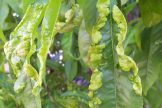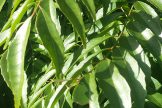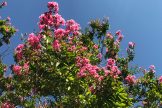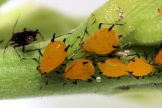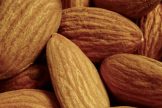
Elm Leaf Beetles are present on most Elms throughout Melbourne. There are many Elm trees in Melbourne, both planted as street trees, in public parks and reserves, and in private gardens. Although the Elm Leaf Beetle is present in significant populations, Dutch Elm Disease, for which the beetle is the carrier, is not present in Australia. This disease has devastated many Elm Tree populations around the world.
Damage Caused
The damage caused to trees is different at different times of the year, depending on the stage in the life cycle of the beetle. In spring new leaves will have many small holes chewed through the leaf, called shot hole damage. This is caused by the adult beetle, a pea – sized, oval shaped beetle with yellow and black stripes.
The adult beetles then lay their eggs on the undersides of the leaves. These hatch out after 7 to 10 days. The larvae hatch out and feed on the green parts of the leaf, completely skeletonising the leaves. In late December the larvae move down the trunk to pupate in the soil and in lower crevices in the bark. After one to two weeks the adult beetles emerge and travel back up the trunk to feed on the foliage. As the weather cools down the beetles seek shelter for the winter months. The beetles will over winter in houses, sheds, wood piles, compost bins, even in vehicles.
In Melbourne, one to two of these cycles occur each year, depending on the seasonal weather. The damage to the trees depends on the health and age of the tree. Older trees that suffer other environmental stresses, such as drought or compaction of the root zone, will be weakened and may decline at a faster rate. Young trees that are otherwise healthy and vigorous will be more able to cope with the beetle infestations each year. Watering trees in drought periods and avoiding damage to the roots will result in healthier trees, more able to cope with the yearly beetle attack.
What can be done?
The aim is not to eradicate Elm Leaf Beetle, but to reduce the numbers so that the damage is minimised. There are several methods that may be used to reduce the numbers of beetles and larvae feeding on your Elm trees.
Trunk banding: Two bands, approximately 20cm apart, of clear film with a band of Tac Gel applied around the trunk. This should be applied early in January as the idea is to trap and kill larvae moving down the trunk to pupate. On smooth barked Elms, sticky packaging tape may be wound in a 20cm wide band around the trunk, with the sticky side facing out. This is a physical trap for larvae moving down the trunk and as such should be replaced when it loses its stick or gets clogged with larvae.
Foliar Sprays: This method is only useful for immediate control of the beetles and larvae feeding on the foliage. This method is difficult for the home gardener to apply due to the size and height of the canopy. For most established trees, this method is both expensive and short term and is the most environmentally damaging. This method is not recommended as an effective and safe control method.
Trunk injection: This method can only be administered by an arborist, as both the technique used, and the equipment used is specific. Most arborists would not recommend this method, as there are more effective and
cheaper ways to control Elm Leaf Beetle.
Need More Information?
Friends of The Elms at Burnley: e-mail foteinc@hotmail.com
There are also several arboriculture services that can help:
Arbor Spray: 0419 546 376
Tree Logic: (03) 9822 2181
Arbor Co: (03) 9804 3366
City Wide Tree Care: 1300 136 234

